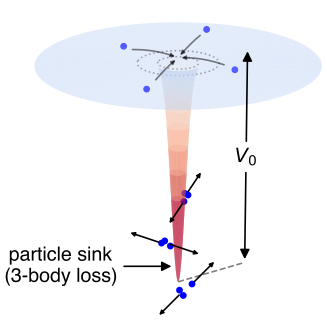Observation of self-oscillating supersonic flow across an acoustic horizon in two dimensions
Authors: Hikaru Tamura, Sergei Khlebnikov, Cheng-An Chen, Chen-Lung Hung
Journal Ref: Phys. Rev. A 112, L031301 (2025); Editors' suggestion.
Abstract:
Understanding the dynamics and stability of transonic flows in quantum fluids is an outstanding challenge, with applications ranging from nonlinear optics and condensed matter to analogue gravity. One intriguing possibility is that a system with a spatially bounded supersonic flow may evolve into a self-oscillating state that periodically emits solitons, in a process originating from the well-known Landau instability. Here, we report observation of self-oscillating supersonic flows in a two-dimensional atomic superfluid. By imposing a local particle sink with strong loss, we induce a convergent radial flow forming an acoustic analogue of a black-hole horizon and an inner horizon around the sink. The observed superflow appears to be modulated by quasi-periodic bursts of superluminal signals. We measure their frequencies and find surprising agreement with numerical simulations of soliton oscillation frequencies within the black-hole horizon. The presented experiment demonstrates a new method for creating supersonic flows in atomic superfluids, which may find applications in quantum simulations of curved spacetime, supersonic turbulence, and self-oscillating dynamics in dissipative many-body systems.
